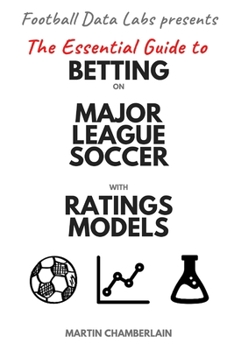The Essential Guide to Betting on Major League Soccer with Ratings Models (2020 Edition)
In collective sports it is often said that teams are more than just the sum of individual players' capabilities. In the betting industry, nevertheless, the single absence of a team's leading player usually leads to movements in the pre-game odds. Indeed, a Los Angeles FC side without Carlos Vela or an Atlanta United side without Josef Martinez will still be considered favorites against any Major League Soccer opposition in their respective conferences, though the absence of those key players will make the markets less certain. As a star player's abilities are widely known to the general public, his potential impact on the game is relatively easy to assess even by non-expert gamblers. And while the exercise of quantifying the value of a team's best player is fairly simple, it is a significantly more difficult to assess the importance of players of a lesser caliber.
In this book, Martin Chamberlain will present a powerful modelling technique based on players' perceived football capabilities that will help gamblers raise their game by quantifying a team's strength on any given matchday. Inspired by the extreme lack of reliable resources targeted at novice football (soccer) gamblers, especially in this era of big data, this book will present a ratings-based modelling tool in Excel that is simple and intuitive to use on the one hand, but also statistically sound on the other.
This book is the second installment of Football Data Labs' ratings models and a first take on Major League Soccer. Drawing on the significant initial interest shown by the readers of 'Premier League Betting models in Excel', this book further develops the models previously proposed and, most importantly, incorporates the constructive feedback received along the way.In the words of many of our readers, our first book on betting with ratings models turned out a 'great book for novice bettors looking to improve their profitability'. In fact, a major default of the few existing books on statistics models and betting in football is their inability to reach non-expert gamblers. Statistics in itself is a discipline that requires years of study in order for one to firstly understand the theory, and only then to be able to properly apply advanced concepts. Books teaching non-expert gamblers about negative binomial distribution and logistic regression to just name a few of the concepts, with the help of Wikipedia articles, is not only absurd, but also dangerous for a punter's bank and betting results. Utilizing black-box functions and algorithms that one does not fully understand wrongly gives the idea that everything is under control, when in fact the punter is blind to the numerous assumptions and hypotheses standing behind those standard statistics tools. Aside, from the very few 'reliable' (to beginner gamblers) statistics sports models books out there, there is the other category of publications looking to trick novice gamblers into easy money promises with the help of unproven track records. Similarly, there are also numerous tipping services out there promising abnormally high strike rates and yields, which might sound credible to recreational gamblers, but turn out in most cases pure scams.
So what should recreational gamblers turn to if the 'scientific' books are too technical and the simpler tipping services/guides are for the most part dishonest schemes?
In an attempt to answer this million dollar question, Football Data Labs proudly launches the Essential Guide to Betting with Ratings Models series: a middle-ground type of publication developing sound and back-tested models presented in a friendly and intuitive manner so that they remain accessible and provide value to any recreational punter not necessarily educated in a technical field.
Welcome to the 2020 edition of the Essential Guide to Betting on Major League Soccer with Ratings Models &n
Related Subjects
Games




